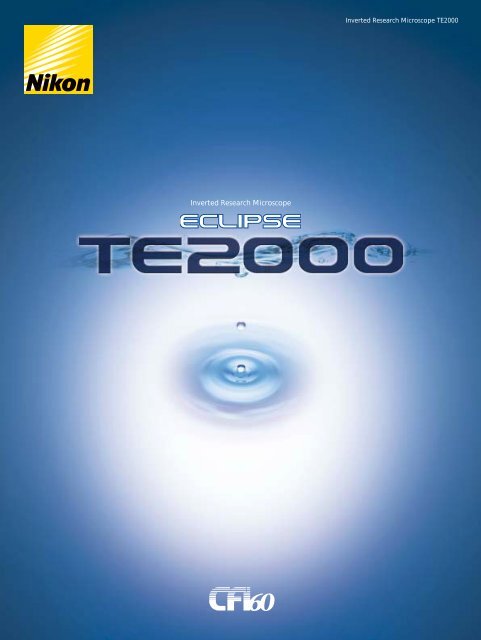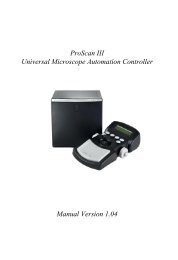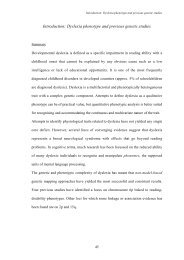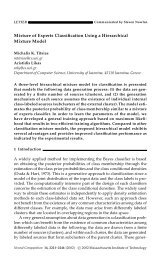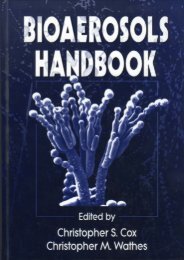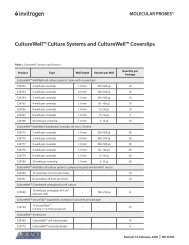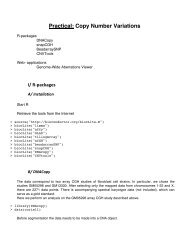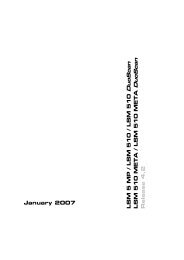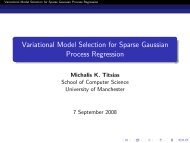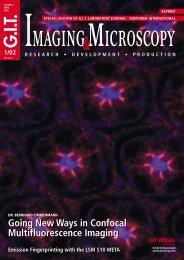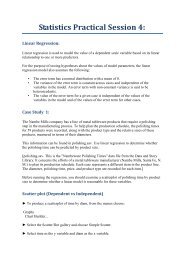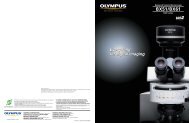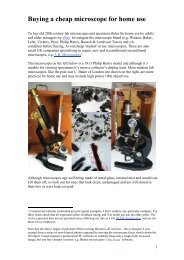En Inverted Research Microscope
En Inverted Research Microscope
En Inverted Research Microscope
You also want an ePaper? Increase the reach of your titles
YUMPU automatically turns print PDFs into web optimized ePapers that Google loves.
<strong>Inverted</strong> <strong>Research</strong> <strong>Microscope</strong><br />
<strong>Inverted</strong> <strong>Research</strong> <strong>Microscope</strong> TE2000
The most advanced live-cell imaging platform available<br />
The new TE2000 series builds on the success of its predecessors elevating inverted microscopy to<br />
extraordinary performance levels. With the introduction of TE2000-PFS (Perfect Focus System),<br />
the series provides the ultimate live-cell imaging platform for cutting-edge research. PFS<br />
guarantees accurate focus for long term observations, and the Noise Terminator assures high<br />
S/N ratio images throughout.<br />
1.<br />
2
The TE2000-S, a basic model<br />
that can be dedicated to<br />
specific tasks, comes with<br />
two output ports.<br />
2.<br />
The TE2000-U is a universal<br />
model that comes standard<br />
with four output ports.<br />
3.<br />
The TE2000-E incorporates a highprecision<br />
motorized focus and<br />
vibration-free motorized optical-path<br />
changeover mechanism that facilitates<br />
image capture in 3D. The TE2000-E<br />
comes with five output ports.<br />
By combining the fully motorized TE2000-E<br />
with the Nikon Perfect Focus System (PFS), the<br />
TE2000-PFS guarantees constant and accurate<br />
focus, making this latest model perfect for<br />
live-cell imaging, including TIRF and long<br />
term, dynamic time-lapse observations.<br />
Configured with an epi-fluorescence attachment<br />
3
Live-cell imaging platform<br />
A powerful motorized microscope with real-time focus correction<br />
Farewell to focus drift!<br />
Focus drift is one of the biggest obstacles in time-lapse<br />
observation.<br />
The new TE2000-PFS (Perfect Focus System) automatically<br />
detects the surface of the coverslip optically and continually<br />
corrects focus to compensate for even the most infinitesimal<br />
changes. Focus is maintained during long term observations<br />
and stage movement. Moreover, the TE2000-PFS includes all<br />
the functions of the acclaimed TE2000-E inverted research<br />
microscope.<br />
• You can continue stable, in-focus observations over<br />
an extended period of time—perfect for time-lapse<br />
recording.<br />
• You can minimize photobleaching, which keeps cells<br />
alive longer in fluorescence observation, through an<br />
overall reduction in the number of images captured.<br />
• You will never again miss sudden changes in your<br />
specimen as PFS instantaneously corrects focus drift or<br />
Z-axis changes resulting from temperature drop when<br />
adding reagents.<br />
• You can freely select focus planes throughout the<br />
specimen and keep focusing on the selected plane<br />
thanks to the Simultaneous Optical Offset feature.<br />
Configured with an epi-fluorescence attachment<br />
PFS can also work in brightfield, phase, and DIC observations.<br />
Principle of focus detection<br />
Always in perfect focus<br />
Nikon Original!<br />
Medium; n: approx 1.35<br />
Glass; n: approx 1.5<br />
Water: n: 1.333<br />
Oil; n: 1.514<br />
or Air; n: 1.0<br />
LED detection light<br />
When PFS is turned on, the position of the coverslip surface is<br />
always detected during observation. The data is continuously<br />
fed back to the extremely accurate Z-axis control focusing<br />
mechanism thanks to Nikon’s propriety COF (Continuous<br />
Optical Feedback) technology*. Focusing precision of less than<br />
1/3 the focal depth of the objective is maintained.<br />
*Patent pending<br />
•PFS on<br />
The coverslip surface* is detected by the LED light emitted through the objective.<br />
*Interface of glass and medium in immersion applications or glass and air in dry applications.<br />
Correction to focus drift caused by expansion/contraction<br />
of the plastic dish when reagents are added<br />
Observation method: Laser TIRF<br />
•PFS off<br />
<br />
Adding reagent<br />
<br />
Adding reagent<br />
4.<br />
4
Perfect focus to the plane of interest<br />
Nikon Original!<br />
Focus detection with infrared light<br />
Focus is continuously corrected at any plane of interest<br />
throughout the specimen by the Simultaneous Optical Offset<br />
feature*. Unlike other systems that have to repeat focusing<br />
on the coverslip surface and then the plane of interest in<br />
alternate shifts, PFS can maintain constant focus on the<br />
plane of interest at millisecond refresh speed. Consequently,<br />
you will never again miss rapid events in your specimen<br />
because of focus drift.<br />
*Patent pending<br />
PFS uses an LED emitting light in the infrared range and an<br />
internal linear CCD detector to detect the precise interface,<br />
so it does not intrude on the visible wavelengths used for<br />
fluorescence emission. This means you can carry out<br />
observation and focus control at the same time, with no<br />
influence at all on captured images. Single fluorescent<br />
molecules can also be visualized at a high S/N ratio.<br />
Single molecular fluorescence image of YFP label receptor<br />
Focus is maintained during time-lapse recording<br />
3 µ m<br />
Contours of the cell<br />
Observation method: DIC<br />
Notes:<br />
• To prevent reduction in transmittance in the near-infrared range (680nm or higher), Nikon<br />
recommends removing the PFS optics from the optical path when PFS is not in use.<br />
• During observation of fluorescent dyes with fluorescence spectrum that reaches the near-infrared<br />
range (740nm or higher), fluorescence signals may affect PFS performance.<br />
0 0.1 0.2 0.3 (s)<br />
photobleach<br />
Cell: dendrite (part) of a primary dispersion culture cell of a hippocampus<br />
Time-lapse image: being photobleached at after 0.3 s<br />
Observation method: TIRF<br />
5.<br />
Motorized microscope for advanced research<br />
The TE2000-E comes standard with linear encoded motorizedfocus<br />
and motorized 5-way light port changeover—perfect for<br />
advanced research that requires high resolution image capture in<br />
3D, including confocal microscopy and deconvolution processing.<br />
TE2000-E configured with confocal system<br />
Streamlined operation from a PC<br />
The microscope can be operated from a<br />
PC using Nikon’s NIS-Elements acquisition<br />
and analysis software or other third-party<br />
application software.<br />
Greater Z-axis precision<br />
The E model features an integrated Z-axis<br />
linear encoded readout of 0.05µm when<br />
controlled through a connected computer.<br />
Objective anti-collision mechanism<br />
The nosepiece automatically drops when<br />
the objectives are being changed,<br />
preventing them from hitting the stage—<br />
particularly useful for live cell observations.<br />
Auto switching between 5 ports<br />
Five output ports, including a bottom port,<br />
are standard and can be easily switched via<br />
motorized control.<br />
External fine focusing unit<br />
Fine focusing can be easily controlled<br />
anywhere on the desktop with this<br />
compact unit.<br />
Remote control unit<br />
All motorized units can be operated easily<br />
in a darkroom thanks to the phosphorescent<br />
display tags.<br />
5
Extendible configuration<br />
Flexible extendibility facilitates the most sophisticated research<br />
Nikon’s “stratum structure” enables flexible extendibility<br />
Taking advantage of infinity optics, the TE2000’s stratum<br />
structure enables the extension of the distance between the<br />
microscope body and objectives by up to 80mm (max.).<br />
This design allows the introduction of equipment such as laser<br />
tweezers or extra illumination into the optical path without<br />
modifying the microscope body as well as a variety of Nikon’s<br />
fluorescence illumination accessories.<br />
Nikon’s “stratum structure” can efficiently provide a perfect<br />
system for your desired application. Multimode imaging<br />
capability is realized with a single microscope.<br />
6.<br />
Optional stage risers (70mm) allow the mounting of<br />
other equipment such as laser tweezers or a laser<br />
unit in addition to an epi-fluorescent attachment<br />
without modifying the microscope body.<br />
Epi-fl attachment<br />
Other attachment<br />
Epi-fl<br />
attachment<br />
70mm<br />
Epi-fl<br />
attachment<br />
Other<br />
attachment<br />
Standard position<br />
Stage risers<br />
6
Multimode imaging as shown below is possible.<br />
C1plus or C1si confocal laser scanning<br />
microscope system<br />
+<br />
TIRF (Total Internal Reflection<br />
Fluorescence)/epi-fluorescence system<br />
+<br />
Laser tweezers<br />
The C1confocal microscope system can be<br />
paired with a combination of epi-fluorescence<br />
and TIRF units. The confocal microscope<br />
system and TIRF unit share one laser light<br />
source, and allow you to observe TIRF and<br />
confocal images of the same specimen with<br />
one microscope. Utilizing the stratum<br />
structure, it is possible to add laser tweezers in<br />
another stratum or level and provide<br />
simultaneous observation with either TIRF,<br />
confocal or epi-fluorescence excitation.<br />
Specimen<br />
Prism<br />
Coverglass<br />
Objective<br />
(CFI Apo TIRF 60X/1.49 oil)<br />
Laser Tweezers<br />
DM (IR reflection,<br />
visible transmitted)<br />
DM (400,<br />
505, 565)<br />
Eyepiece Tube, Camera Port<br />
Top Position<br />
Bottom Position<br />
TIRF/Epi-fl Attachment<br />
Mercury Lamp<br />
Beam<br />
splitter<br />
Fiber<br />
C1 confocal scanning head<br />
Laser<br />
(1064nm)<br />
Laser<br />
(488nm, 532nm)<br />
Detector<br />
Epi-fl illumination<br />
+<br />
Near-IR-DIC attachment/FRET system<br />
+<br />
CCTV camera<br />
IR Filter<br />
Halogen<br />
Lamp<br />
Specimen<br />
Coverglass<br />
Utilizing the stratum structure, it is possible to<br />
mount an epi-fl illumination system and a<br />
near-infrared DIC attachment. The image can<br />
be observed under epi-fl illumination<br />
simultaneously with viewing of dynamics of<br />
living cells with near-IR DIC illumination as the<br />
image can be divided into two wavelengths by<br />
a dichroic mirror inside the filter turret of the<br />
near-IR DIC attachment.<br />
In addition, FRET images can be captured with<br />
a spectrophotometer attachment.<br />
Furthermore, simultaneous photometry of<br />
multiple fluorescence wavelengths with multiphoton<br />
excitation is possible.<br />
Prism<br />
Objective<br />
(CFI Plan Apo VC 60X WI)<br />
Eyepiece Tube, Camera Port<br />
DM (400, 505, 565)<br />
Top Position<br />
Epi-fl Illumination System<br />
Bottom Position<br />
Near-IR DIC Attachment<br />
DM ( = 780nm reflection,<br />
visible transmitted)<br />
Dual-Wavelength<br />
Spectrophotometer<br />
High-speed<br />
Spectroscopic<br />
Fiber Illuminator<br />
IR CCD Camera for<br />
Edge Detection<br />
7
Epi-fluorescence images with<br />
high contrast<br />
Noise Terminator mechanism<br />
Responding to an increasing demand for fluorescence<br />
observation of higher S/N ratio images, Nikon created a new<br />
mechanism, Noise Terminator. The TE2000 incorporates this<br />
mechanism in the fluorescence illuminator and filter cubes to<br />
totally absorb stray light in the optical path. This significantly<br />
reduces noise and dramatically increases fluorescence image<br />
contrast.<br />
Light<br />
source<br />
Lenses<br />
Light absorbing material<br />
ND<br />
Stray light<br />
Fluorescence<br />
filter cube<br />
Nikon’s two process mechanism first removes stray light from the filter<br />
cube completely, then absorbs it through the light absorbing material.<br />
Therefore stray light is eliminated thoroughly.<br />
High Quality Fluorescence Filters<br />
Viewed with a high quality filter<br />
Each filter/mirror incorporated in these filters has a very sharp rising<br />
edge at the corresponding wavelength. By minimizing the crossover<br />
of each signal, Nikon succeeded in significantly reducing the loss of<br />
excitation wavelength. As a result these filters can provide high<br />
quality epi-fluorescence images. There are three types of filters: CFP,<br />
GFP, and YFP.<br />
Viewed with a conventional filter<br />
7.<br />
High performance DIC prisms<br />
7.<br />
The best balance of high contrast and high resolution<br />
By changing the material structure, Nikon succeeded in<br />
significantly improving the functionality of the standard<br />
combination of DIC modules and sliders.<br />
The excellent balance of contrast and resolution produces high<br />
quality DIC images with no color blur at any magnification.<br />
Depending upon the type of specimen, either a high-contrast or<br />
high-resolution combination is selectable.<br />
8
CFI60 optical system<br />
Clear, aberration-free images at any magnification<br />
The TE2000 utilizes Nikon’s world renowned CFI60 infinity<br />
optics, known for crisp and clear images at any magnification,<br />
while providing higher NAs and longer working distances. The<br />
focal length of the tube lens is ideal at 200mm, which avoids<br />
induced aberration even when you introduce phase rings, DIC<br />
prisms or dichroic mirrors into the optical path.<br />
New Series of Objectives Created with Nikon’s Accumulated Optical Technologies<br />
CFI Plan Apochromat VC Series<br />
CFI Plan Apochromat VC 60X Oil, NA 1.40<br />
CFI Plan Apochromat VC 60X Wl, NA 1.20<br />
CFI Plan Apochromat VC 100X Oil, NA 1.40<br />
• Chromatic aberrations have been thoroughly correct<br />
throughout the view field. Suitable for digital imaging.<br />
• Perfect choice for multi-stained, fluorescence specimens and<br />
when using brightfield and DIC techniques.<br />
• Axial chromatic aberration has been corrected up to the violet<br />
range (405nm), making these objectives highly effective for<br />
confocal applications.<br />
• Excellent brightness throughout the view field.<br />
• The 60X water-immersion type, in particular, features high<br />
spectral transmittance, even in the 360nm wavelength range.<br />
CFI Apochromat TIRF Series<br />
CFI Apochromat TIRF 60X Oil, NA 1.49 w/correction collar<br />
CFI Apochromat TIRF 100X Oil, NA 1.49 w/correction collar<br />
• The unprecedentedly high NA of 1.49 enables excitation on an<br />
even thinner field to produce high S/N ratio TIRF images.<br />
• The world’s-first temperature-change spherical aberration<br />
correction ring is provided for in the objective design. Users<br />
can easily counteract the influences to the image quality from<br />
temperature-induced changes—from 23ºC (room temperature)<br />
to 37ºC (physical temperature)—in the refractive index of the<br />
immersion oil.<br />
• The correction ring works perfectly in both DIC and epifluorescence<br />
microscopy of minute structures. It is also suitable<br />
for the laser tweezer method.<br />
• To be used with a regular coverglass and immersion oil.<br />
Intensity distribution of dot image<br />
23ºC 37ºC before correction<br />
When the temperature changes,<br />
aberration occurs.<br />
37ºC after correction<br />
Aberration can be corrected<br />
using the correction ring.<br />
9
Multiport design<br />
Multiport design broadens the range of observation and measurement<br />
The TE2000-PFS and TE2000-E have 5 ports. The TE2000-U has 4 ports.<br />
The TE2000-S has 2 ports. These ports distribute light in the ratios given<br />
below. The TE2000 can capture or analyze images with multiple cameras.<br />
Main body<br />
Port select address<br />
1 2 3 4 5<br />
TE2000-PFS Eye 100% Right 80% Bottom Front 80% Left 100%<br />
TE2000-E Eye 20% 100%* 1 Eye 20%<br />
TE2000-U Eye 100% Right 80% (Optional) Front 80% Left 100%<br />
Eye 20% * 2 Eye 20%<br />
TE2000-S Eye 100% Left 80% – – –<br />
Eye 20%* 3<br />
By changing the optional prism, the light distribution ratio of<br />
the shaded portions can be changed as below.<br />
*1 Right: 100 Front: 100 Left: 80 (Eye: 20)<br />
*2 Right: 100 Front: 100 Left: 80 (Eye: 20)<br />
*3 Left: 100<br />
The following portions can also be changed by altering the<br />
microscope body.<br />
(Optional at the time of purchase)<br />
*2 Bottom: 100<br />
*3 Right: 100<br />
Intermediate magnification module 1x-1.5x<br />
TE2000-U/E/PFS<br />
Magnifications of all ports of the TE2000-PFS, TE2000-E<br />
and TE2000-U, including the observation port, can be<br />
easily changed without the troublesome adjustment<br />
accompanying the change of objectives.<br />
<strong>En</strong>hanced overall rigidity<br />
Sturdy design and thermal stability improve precision,<br />
minimize focus deviations<br />
Stability for greater precision<br />
To achieve stability that supports focusing precision, Nikon<br />
implemented Computer Assisted <strong>En</strong>gineering (CAE) and<br />
adopted a new high-strength alloy material in the microscope<br />
body. This doubled the rigidity compared with previous models.<br />
Improved thermal stability<br />
10<br />
To minimize focus deviation due to temperature change, Nikon<br />
has reinforced the thermal stability of the microscope body, thus<br />
improving image quality during long hours of observation or<br />
photography.<br />
Glass stage ring<br />
This glass stage ring ensures minimum<br />
deformation caused by temperature change,<br />
minimizing blurred focus; so it is suitable for<br />
time lapse imaging.
User-friendly ergonomic design<br />
Design innovations ensure hours of comfortable, strain-free use<br />
Nikon has instituted numerous innovations to provide<br />
comfortable operation and reduce strain, even over a<br />
prolonged period of operation.<br />
Knobs and buttons<br />
Frequently used buttons and controls are all located at the<br />
front and within easy reach.<br />
Main controls are concentrated in the<br />
front, close to the operator.<br />
Fine focusing unit<br />
The TE2000-PFS and TE2000-E come with a compact<br />
external fine focusing unit that can be placed anywhere on<br />
the desktop.<br />
Nosepiece<br />
The nosepiece is inclined to the left, making it easy to read<br />
the magnification and adjust the correction ring.<br />
External fine focusing unit<br />
Stage height<br />
Nosepiece is inclined to the left for easy<br />
handling.<br />
The low-profile stage facilitates handling of specimens.<br />
Eyepiece tube<br />
The 25º -inclination eyepiece tube minimizes fatigue during<br />
long hours of observation, while its Y-shaped design<br />
permits easy viewing of the specimen area on the stage.<br />
Ergonomic tube<br />
An ergonomic tilting eyepiece tube is optionally available.<br />
Furnished with a built-in Bertrand lens, the inclination angle<br />
is adjustable from 15º to 45º for viewing in a relaxed and<br />
comfortable posture.<br />
Ergonomic tube<br />
Eye-level riser<br />
Eye-level riser (as indicated by arrow)<br />
Optimal eyepiece height can be achieved by using optional<br />
eye-level risers. Each riser has a thickness of 25mm and up<br />
to two risers can be installed at a time. (The eye-level riser<br />
cannot be used with a stage riser)<br />
Large stage-handle knob<br />
Attaching the optional large stage-handle knob enables<br />
precise operation for the fine movement of the stage<br />
during high magnification observations.<br />
Large stage-handle knob<br />
11
Retrofittable motorized options<br />
Motorized operation with greater precision and<br />
operability facilitates top-notch research<br />
All four models accept retrofittable motorized accessories,<br />
allowing researchers to not only choose the desired combinations,<br />
but also to control the microscope from external PCs.<br />
Flexible motorized operation for a variety of uses<br />
• A wide variety of motorized accessories are available and can<br />
be controlled by an external computer when a HUB controller<br />
is attached.<br />
• Motorized switching of objectives and observation methods<br />
between epi-fluorescence, Nomarski DIC, phase contrast,<br />
Hoffman Modulation Contrast is possible*.<br />
*There are some restrictions depending on the combination of model and<br />
observation method.<br />
Motorized barrier filter wheel<br />
This motorized barrier filter wheel<br />
with a turret rotary system can<br />
mount up to 8 ø25mm barrier<br />
filters.<br />
Motorized system condenser turret<br />
This motorized turret for system<br />
condensers enables easier switching<br />
between brightfield, phase contrast,<br />
Nomarski DIC, and Hoffman<br />
modulation contrast observations.<br />
Motorized sextuple DIC nosepiece<br />
This nosepiece can be used for all<br />
observations including DIC. When the<br />
magnifications are being changed,<br />
the nosepiece automatically descends<br />
for easy, safe rotation of the<br />
objectives and then returns to the<br />
original height after rotation (only in<br />
combination with the TE2000-PFS or<br />
TE2000-E model).<br />
Motorized epi-fl filter rotating turret<br />
A maximum of 6 epi-fl filter cubes<br />
can be mounted and easily changed<br />
with a remote control unit, even in<br />
dark rooms.<br />
12
Communication HUB controller<br />
The HUB controller manages all the<br />
cables of each motorized unit at the<br />
back of the microscope. By<br />
connecting to the RS-232C interface<br />
of a PC, motorized units can be<br />
controlled from the PC.<br />
Epi-fl attachment with motorized shutter<br />
This epi-fluorescence attachment<br />
has a built-in motorized illumination<br />
shutter.<br />
Motorized excitation filter wheel<br />
This motorized excitation filter<br />
wheel with a turret rotary system<br />
can mount up to 8 ø25mm<br />
excitation filters.<br />
Motorized analyzer<br />
This motorized analyzer is used to<br />
remove and insert an analyzer for<br />
Nomarski DIC.<br />
Remote control unit<br />
7 8<br />
All motorized units attached to the<br />
microscope can be operated from this<br />
control pad with an LCD screen. Filter<br />
position labels glow in the dark for easy<br />
identification.<br />
3<br />
4<br />
1<br />
2<br />
6<br />
9<br />
!<br />
#<br />
$<br />
5<br />
)<br />
"<br />
%<br />
&<br />
(<br />
1. LCD Display<br />
2. Objectives Changeover<br />
3. Shutter Open/Close<br />
4. Excitation Filter Changeover<br />
5. Barrier Filter Changeover<br />
6. Fluorescence Filter Block Changeover<br />
7. Z-axis Reset<br />
8. External Signal Output<br />
9. LCD Operation Mode Changeover<br />
10. LCD Backlight On/Off<br />
11. LCD Brightness Control<br />
12. Diascopic Lamp Control by Remote Pad<br />
13. Diascopic Lamp On/Off<br />
14. Diascopic Lamp Brightness Control<br />
15. Condenser Cassette Changeover<br />
16. Analyzer In/Out<br />
17. Light Path Changing Prism Changeover<br />
13
Basic Observation Methods<br />
Epi-fluorescence<br />
Flawless, high-contrast fluorescence images<br />
Thanks to a noise terminator mechanism and zoom<br />
illumination, the TE2000 achieves an unparalleled<br />
S/N ratio and brightness. It performs well even for<br />
weak, single-molecular-level fluorescence<br />
observations at leading-edge research.<br />
8.<br />
10.<br />
9.<br />
The Noise Terminator mechanism directs<br />
deviated stray light out of the optical<br />
path. This results in images of high<br />
contrast and unparalleled S/N ratio.<br />
High quality fluorescence filters<br />
Each filter/mirror incorporated in these filters has a<br />
very sharp rising edge at the corresponding<br />
wavelength that minimizes the crossover of signals.<br />
Zoom-type lamphouse adapter allows the<br />
operator to increase light intensity.<br />
Remote control unit and filter turret use<br />
phosphorescent display tags to enhance<br />
visibility during operation in dark rooms.<br />
14
Nomarski DIC<br />
With the new DIC system, it is possible to obtain<br />
the best image appropriate to the needs<br />
Uniform coloration<br />
Excellent images with uniform coloration are now<br />
possible, at any magnifications, by changing the<br />
material composition of the DIC prisms.<br />
Using Rotating Senarmont Compensation method<br />
Rotate polarizer<br />
to change DIC contrast.<br />
The perfect balance of high contrast and<br />
high resolution<br />
The standard DIC prisms for the system condenser<br />
can cover observation at 10X-100X with only two<br />
modules that are greatly balanced in contrast and<br />
resolution at any magnification. To further closely<br />
fit your specific observation needs and specimens,<br />
the high contrast DIC prisms and high<br />
resolution DIC prisms are also selectable.<br />
Polarizer<br />
1/4 Plate<br />
de Senarmont<br />
Compensator<br />
DIC Prism<br />
Slider<br />
High resolution DIC<br />
Observe ultra-minute structures at full optical performance<br />
High NA condensers (Dry, Oil) are available to<br />
specifically address the needs for further detailed<br />
DIC images of high magnification observations.<br />
These configurations are optimized for a high<br />
resolution video enhanced contrast DIC system.<br />
Ultra-high resolution DIC prisms consisting of a<br />
high transmission polarizer and analyzer for each<br />
dry and oil type condenser are selectable in<br />
addition to standard DIC prisms.<br />
11.<br />
Epi-fluorescence and Nomarski DIC<br />
By combining epi-fluorescence and DIC it is easy to<br />
accurately locate fluorescent tagged structures or<br />
artifacts within a specimen.<br />
12.<br />
15
Viewed with an ADL objective<br />
Phase contrast<br />
<strong>En</strong>ables high-contrast imagery of minute living<br />
cells<br />
Viewed with a conventional phase<br />
contrast objective<br />
Phase contrast is the most popular observation<br />
method for inverted microscopes. This method<br />
does not require the staining of the specimen,<br />
therefore you can observe and research precise<br />
structures of living cells without influencing the live<br />
organism.<br />
13.<br />
CFI Plan Fluor ELWD ADL objectives<br />
Nikon developed Apodized phase contrast<br />
objectives to effectively reduce halos, which was<br />
considered troublesome with the conventional<br />
phase contrast method. The internal structures of<br />
cells ongoing cell division or thick phase objects<br />
used to submerge in halos, making observation<br />
difficult, but they are now visible with excellent<br />
contrast and a much wider tonal range.<br />
CFI Plan Fluor ADH 100x (Oil) objective<br />
This newly developed high-sensitivity Apodized<br />
phase contrast objective dramatically reduces the<br />
effect of halo and doubles the contrast of minute<br />
objects compared to conventional phase contrast<br />
objectives, enabling visualization of minute<br />
structures in living tissue and low contrast<br />
structures.<br />
ADL objective series<br />
Viewed with an<br />
ADH objective<br />
13.<br />
Viewed with a conventional<br />
phase contrast objective<br />
ADH 100x (Oil) objective<br />
14. 14.<br />
Hoffman Modulation Contrast®<br />
3D-like images made easy<br />
This technique permits observation of living<br />
specimens using plastic petri dishes, which is not<br />
possible with DIC. The combination of dedicated<br />
HMC objectives and HMC condenser components<br />
creates high contrast 3D-like images of living<br />
transparent specimens without the halos seen under<br />
phase contrast.<br />
15.<br />
Note: Hoffman Modulation Contrast and HMC are registered trademarks of Modulation Optics, Inc.<br />
16
Applications<br />
DIGITAL ECLIPSE C1si<br />
A true spectral imaging confocal laser scanning<br />
microscope system that can capture spectra<br />
across a wide 320nm range with a single scan<br />
• 32-channel simultaneous acquisition suppresses<br />
damage to specimens.<br />
• Selectable wavelength resolution from 2.5, 5 or<br />
10nm, independent of pin-hole diameter.<br />
• Acquisition of accurate fluorescence spectra<br />
enables color rendering of fluorescence images<br />
with greater realism.<br />
• Polarization-enhanced optical sensitivity with DEES<br />
improves brightness.<br />
• DISP (Dual Integration Signal Processing) eliminates<br />
digitization dead time.<br />
• Spectral imaging via simple switchover from a<br />
3-channel PMT detector.<br />
Overlay of 32-channel images acquired with<br />
one shot<br />
Time-lapse recording of 320nm wide spectra<br />
Fluorescence<br />
power<br />
(pixel value)<br />
3500<br />
Time<br />
(sec.)<br />
3000<br />
16.<br />
1680<br />
1440<br />
1200<br />
960<br />
2500<br />
2000<br />
1500<br />
720<br />
1000<br />
480<br />
500<br />
240<br />
0<br />
0<br />
530 545 560 575 590 605<br />
Fluorescence wavelength (nm)<br />
DIGITAL ECLIPSE C1 plus<br />
The C1 compact, high performance personal type<br />
confocal microscope system now supports FRAP<br />
• Simultaneous 3-channel fluorescence, 3-channel plus DIC, time-lapse<br />
recording and spatial analysis are possible.<br />
• Filters can be easily exchanged by users to match the latest fluorescent dyes.<br />
• ROI scanning is possible with an optional AOM (Acousto Optical<br />
Modulator)—perfect for FRAP (Fluorescence Recovery After Photobleaching).<br />
• Bi-Directional Scan improves frame rates. Scan Rotation is also possible.<br />
• A greater variety of lasers can be mounted.<br />
Bleached<br />
17.<br />
After 2 sec.<br />
After 30 sec.<br />
After 120 sec.<br />
17
Laser TIRF-2 system<br />
High signal to noise (S/N) optimizes observation of<br />
single molecule activity in fluorescence observation<br />
• A unification of a laser TIRF unit and epi-fluorescence illumination system.<br />
Switching the systems is elementary.<br />
• Responds to various levels of research such as from epi-fluorescence<br />
observation of living organisms to observation of living cells at the<br />
molecular level.<br />
• Captures single molecule activity in living cells with an extraordinary high<br />
S/N ratio where they contact the coverglass.<br />
• The TE2000’s unique “stratum structure” allows the simultaneous<br />
mounting of laser tweezers.<br />
18.<br />
Image under TIRF observation<br />
Image under epi-fluorescence<br />
observation<br />
TIRF/epi-fluorescence image<br />
overlay (pseudo-color)<br />
White light TIRF system<br />
Easily realizes TIRF observation without using<br />
laser illumination<br />
• A TIRF function has been provided with the epi-fluorescence attachment. TIRF<br />
observation using mercury illumination is available. Xenon and high-intensity<br />
halogen can also be used.<br />
• Simply inserting an exclusive aperture (60X, 100X) enables switching to TIRF.<br />
• The wide wavelength band of mercury illumination makes multiple<br />
wavelength observation possible by changing the filter. No worries for<br />
interference patterns.<br />
Mercury TIRF image<br />
Epi-fluorescence image<br />
Photic stimulation unit<br />
Easily realizes photic stimulation without a<br />
confocal microscope system<br />
• Compact and easy to attach, easy to operate.<br />
• Observation of molecule movement by photic stimulation in a cell is possible,<br />
using fluorescence protein such as Kaede (photo conversion) and PA-GFP<br />
(photo activation).<br />
• Achieves short wavelength correction up to 405nm (h-line). Combined with VC<br />
series objectives, in which aberration is corrected to 405nm, it illuminates the<br />
targeted area with high precision.<br />
18<br />
Time-lapse images after stimulation can be recorded in series.
Live cell accessories<br />
NT-88-V3 micromanipulator system<br />
A packaged set of instrumentation required for cellular<br />
micromanipulation, the NT-88-V3 is ideal for IVF (in-vitro<br />
fertilization), ICSI (intracytoplasmic sperm injection),<br />
electrophysiology, or biotechnology applications.<br />
Stage incubation system INU-NI-F1<br />
This all-in-one compact CO2 incubator sustains the internal<br />
temperature at 37ºC with humidity of 90% and CO2 of 5%<br />
to keep the specimen in a stable and precise condition. A<br />
special technique that minimizes focus blur facilitates long<br />
hours of time-lapse imaging.<br />
Incubator<br />
With an acrylic plastic enclosure providing easy access to the<br />
specimen area, this accessory utilizes warm air circulation<br />
and maintains the temperature of the interior at 37ºC. The<br />
temperature is also adjustable from room temperature to<br />
40ºC.<br />
Thermal plate warmer<br />
A temperature controllable stage ring with a glass heating<br />
plate keeps the specimen at a set temperature. Temperature<br />
is adjustable from room temperature to 50ºC in 0.1ºC<br />
increments.<br />
19
Digital cameras for microscopes<br />
DXM 1200C<br />
The high-definition cooled color digital camera with a Peltier<br />
cooling mechanism captures weak fluorescing images clearly by<br />
minimizing background noise.<br />
• Super high resolution images with 12.6-mega output pixels.<br />
• High sensitivity reduces shooting time and avoids photobleaching.<br />
• High 15-fps (maximum) transfer rate ensures smooth live images.<br />
• Easy-to-use control software facilitates large-volume shooting.<br />
Digital Sight Series<br />
The Digital Sight series offers a choice of six camera heads and two control<br />
units, enabling an image capturing system to be assembled to suit each use.<br />
High-sensitivity cooled monochrome camera head DS-Qi1<br />
• Superior quantitivity with linearity of >98%.<br />
• High sensitivity equivalent to ISO 800.<br />
• Low noise design with average dark current of<br />
0.7e-/pixel/s.<br />
• High frame rate, 1.5-megapixel cooled<br />
monochrome CCD.<br />
High-definition cooled color camera head DS-5Mc<br />
• Cooling mechanism retains CCD at room<br />
temperature minus 20°C.<br />
• Reduces heat noise.<br />
• High-definition 5.0-megapixel color CCD.<br />
Configured with DS-5Mc-U2<br />
High-speed cooled monochrome camera head DS-2MBWc<br />
• Cooling mechanism retains CCD at room<br />
temperature minus 20°C.<br />
• Reduces heat noise.<br />
• High-frame-rate and high-sensitivity 2.0-<br />
megapixel monochrome CCD.<br />
High-definition/high-speed color camera head DS-Fi1<br />
• High-definition 5.0-megapixel color CCD.<br />
• High resolution and high frame rate.<br />
• High dynamic range and accurate color<br />
reproduction.<br />
• Reduces noise.<br />
High-speed color camera head DS-2Mv<br />
• High frame rate, 2.0-megapixel color CCD.<br />
High-speed monochrome camera head DS-2MBW<br />
• High-frame-rate and high-sensitivity 2.0-<br />
megapixel monochrome CCD.<br />
PC-use control unit DS-U2<br />
• Compact, space-saving design.<br />
• High-speed image transfer to PC via USB<br />
2.0 connection.<br />
• Versatile image capture, processing,<br />
measurement and analysis when coupled<br />
with imaging software NIS-Elements.<br />
• Allows control of Nikon motorized<br />
microscopes.<br />
Standalone control unit DS-L2<br />
• Large 8.4-in. LCD monitor (XGA).<br />
• Pre-programmed imaging modes for<br />
different observation methods.<br />
• Various digital interfaces including USB 2.0<br />
connection.<br />
• Direct print possible.<br />
• Allows control of Nikon motorized<br />
microscopes.<br />
20
Imaging software<br />
NIS-Elements<br />
Advanced solutions for your imaging world<br />
Nikon’s NIS-Elements software provides an integrated<br />
solution by delivering automated intelligence to microscopes,<br />
cameras, components and peripherals.<br />
It handles multi-dimensional imaging tasks with support for<br />
capture, display, peripheral device control, and data<br />
management & analysis of images.<br />
The database building feature for handling large numbers of<br />
multi-dimensional image files enables efficient and fully<br />
documented experiments. The intuitive interface simplifies<br />
workflow, and fast image acquisition speeds via direct<br />
streaming to RAM allow the recording of rapid biological<br />
events. The software also supports numerous image<br />
processing capabilities including binary and morphological<br />
tools for measurement and analysis routines.<br />
The unified control of the entire imaging system offers<br />
significant benefits for cutting-edge research applications<br />
such as live cell imaging.<br />
Three distinct packages for specific application requirements<br />
are available.<br />
Ar NIS-Elements AR (Advanced <strong>Research</strong>)—for fully<br />
automated acquisition and device control through full 6D<br />
(X, Y, Z, Lambda (wavelength), Time, multipoint) image<br />
acquisition and analysis.<br />
Br NIS-Elements BR (Basic <strong>Research</strong>)—for acquisition and<br />
device control through 4D (such as X, Y, Z, Time and X, Y,<br />
Z, Lambda (wavelength)) acquisition.<br />
D NIS-Elements D (Documentation)—for supporting color<br />
documentation requirements in bioresearch, clinical and<br />
industrial applications, with basic measuring and reporting<br />
capabilities.<br />
Real time 2D deconvolution<br />
Data management (Built-in image database)<br />
Allows one-click image acquisition and transfer from a<br />
camera to a user defined database.<br />
Report generation<br />
The database supports image and meta-data export to a<br />
report generator, enabling users to create report templates<br />
and printed or PDF-based reports.<br />
Large image stitching<br />
Ultra-high resolution images can be captured with a<br />
motorized stage using sophisticated auto focus.<br />
EDF (Extended Depth of Focus): plug-in<br />
Allows the creation of an all-in-focus image from a series of<br />
Z-axis image stacks providing 3D modeling capability and a<br />
multi-dimensional image viewer.<br />
Real time 2D deconvolution: plug-in<br />
Supports live on-the-fly or captured deconvolution of an<br />
entire image, or specific regions of interest.<br />
Visit www.nis-elements.com for more detailed information.<br />
Merge channels<br />
21
CFI60 Objectives<br />
Description NA W.D. (mm) Remarks<br />
Brightfield<br />
Achromat flat field CFI Achromat 4X 0.10 30.0<br />
22<br />
CFI Achromat 10X 0.25 7.0<br />
CFI75 LWD 16XW 0.8 (at 16X) 3.0 Water dipping<br />
CFI Achromat LWD 20X 0.40 3.8<br />
CFI Achromat 40X 0.65 0.65 Spring loaded<br />
CFI Achromat LWD 40XC 0.55 2.7-1.7 C.C.0-2<br />
CFI Achromat 60X 0.80 0.3 Spring loaded<br />
CFI Achromat 100X oil 1.25 0.23 Spring loaded<br />
CFI Achromat 100X oil, iris 0.5-1.25 0.23 Spring loaded with iris<br />
Plan Achromat CFI Plan Achromat UW 1X 0.04 3.2<br />
CFI Plan Achromat UW 2X 0.06 7.5<br />
CFI Plan Achromat 4X 0.10 30.0<br />
CFI Plan Achromat 10X 0.25 10.5<br />
CFI Plan Achromat 20X 0.40 1.3<br />
CFI Plan Achromat 40X 0.65 0.57 Spring loaded<br />
CFI Plan Achromat 40X NCG 0.65 0.48 Spring loaded No cover glass<br />
CFI Plan Achromat 50X oil 0.90 0.35 Spring loaded<br />
CFI Plan Achromat 100X oil 1.25 0.17 Spring loaded<br />
CFI Plan Achromat 100X WI 1.10 2.5 Spring loaded with temperature correction ring<br />
CFI Plan Achromat 100X NCG 0.90 0.26 Spring loaded No cover glass<br />
Fluor CFI Fluor 10X W 0.30 2.0 Water dipping<br />
CFI Fluor 20X W 0.50 2.0 Water dipping<br />
CFI Fluor 40X W 0.80 2.0 Water dipping<br />
CFI Fluor 60X W 1.00 2.0 Water dipping<br />
Plan Fluor CFI Plan Fluor 4X 0.13 17.1<br />
CFI Plan Fluor 10X 0.30 16.0<br />
CFI Plan Fluor 10XW 0.3 3.5 Water dipping<br />
CFI Plan Fluor 20X 0.50 2.1<br />
CFI Plan Fluor ELWD 20XC 0.45 8.1-7.0 C.C.0-2<br />
Oil 0.35; Spring loaded Multi-immersion; Oil-glycerin-water<br />
CFI Plan Fluor 20X MI 0.75 Glycerin 0.34;<br />
Water 0.33<br />
CFI Plan Fluor 40X 0.75 0.66 Spring loaded<br />
CFI Plan Fluor 40X oil 1.30 0.2 Spring loaded Stopper<br />
CFI Plan Fluor ELWD 40XC 0.60 3.7-2.7 C.C.0-2<br />
CFI Plan Fluor 60XC 0.85 0.3 Spring loaded C.C.0.11-0.23<br />
CFI Plan Fluor 60X oil, iris 0.5-1.25 0.22 Spring loaded with iris<br />
CFI Plan Fluor ELWD 60XC 0.70 2.1-1.5 C.C.0.5-1.5<br />
CFI Plan Fluor 100X dry 0.90 0.3 Spring loaded C.C.0.14-0.2<br />
CFI Plan Fluor 100X oil 1.30 0.16 Spring loaded Stopper<br />
CFI Plan Fluor 100X oil, iris 0.5-1.3 0.16 Spring loaded with iris<br />
Apochromat CFI Apo 40XW NIR 0.8 3.5 Water dipping<br />
CFI Apo 60XW NIR 1.00 2.8 Water dipping<br />
CFI Apo TIRF 60X oil 1.49 0.13 C.C. 0.13-0.22<br />
CFI Apo TIRF 100X oil 1.49 0.12 C.C. 0.13-0.20<br />
Plan Apochromat CFI Plan Apochromat 2X 0.10 8.5<br />
CFI Plan Apochromat 4X 0.20 20.0<br />
CFI Plan Apochromat 10X 0.45 4.0<br />
CFI Plan Apochromat 20X 0.75 1.0 Spring loaded<br />
CFI Plan Apochromat 40XC 0.95 0.14 Spring loaded C.C.0.11-0.23<br />
CFI Plan Apochromat 40X oil 1.00 0.16 Spring loaded Stopper<br />
CFI Plan Apochromat 60XC 0.95 0.15 Spring loaded C.C.0.11-0.23<br />
CFI Plan Apochromat 100X NCG oil 1.40 0.17<br />
Plan Apochromat VC CFI Plan Apochromat VC 60X oil 1.40 0.13 Spring loaded Stopper<br />
CFI Plan Apochromat VC 60X WI 1.20 0.27 Spring loaded CC.0.15-0.18; Water-immersion<br />
CFI Plan Apochromat VC 100X oil 1.40 0.13 Spring loaded Stopper<br />
S Fluor CFI S Fluor 4X 0.20 15.5<br />
CFI S Fluor 10X 0.50 1.2 Spring loaded<br />
CFI S Fluor 20X 0.75 1.0 Spring loaded<br />
CFI S Fluor 40XC 0.90 0.3 Spring loaded C.C.0.11-0.23<br />
CFI S Fluor 40X oil 1.30 0.22 Spring loaded Stopper<br />
CFI S Fluor 100X oil, iris 0.5-1.30 0.2 Spring loaded
Description NA W.D. (mm) Remarks<br />
Phase Contrast<br />
Achromat flat field<br />
Phase ring<br />
CFI Achromat DL 10X 0.25 7.0 Ph1<br />
CFI Achromat ADL 10X 0.25 6.2 CG 1.2 Ph1<br />
CFI Achromat LWD DL 20X 0.40 3.8 Ph1<br />
CFI Achromat LWD DL 20XF 0.40 3.0 CG 1.2 Ph1<br />
CFI Achromat LWD ADL 20XF 0.40 3.0 CG 1.2 Ph1<br />
CFI Achromat DL 40X 0.65 0.65 Spring loaded Ph2<br />
CFI Achromat LWD DL 40XC 0.55 2.7-1.7 C.C.0-2 Ph2<br />
CFI Achromat LWD ADL 40XF 0.55 2.1 CG 1.2 Ph1<br />
CFI Achromat LWD ADL 40XC 0.55 2.7-1.7 C.C.0-2 Ph2<br />
CFI Achromat DL 100X oil 1.25 0.23 Spring loaded Ph3<br />
CFI Achromat BM 10x 0.25 6.10 Ph1<br />
Plan Achromat CFI Plan Achromat DL 10X 0.25 10.5 Ph1<br />
CFI Plan Achromat DL 20X 0.40 1.3 Ph1<br />
CFI Plan Achromat DL 40X 0.65 0.57 Spring loaded Ph2<br />
CFI Plan Achromat DL 100X oil 1.25 0.17 Spring loaded Ph3<br />
Fluor CFI Fluor DLL 40XW 0.80 2.0 Water dipping Ph2<br />
Plan Fluor CFI Plan Fluor DL 4X 0.13 16.4 CG 1.2 PhL<br />
CFI Plan Fluor DLL 10X 0.30 16.0 Ph1<br />
CFI Plan Fluor DL 10X 0.30 15.2 CG 1.2 Ph1<br />
CFI Plan Fluor DLL 20X 0.50 2.1 Ph1<br />
CFI Plan Fluor ELWD DM 20XC 0.45 8.1-7.0 C.C.0-2 Ph1<br />
CFI Plan Fluor ELWD ADL 20XC 0.45 8.1-7.0 C.C.0-2 Ph1<br />
CFI Plan Fluor DLL 40X 0.75 0.66 Spring loaded Ph2<br />
CFI Plan Fluor ELWD DM 40XC 0.60 3.7-2.7 C.C.0-2 Ph2<br />
CFI Plan Fluor ELWD ADL 40XC 0.60 3.7-2.7 Spring loaded C.C.0-2 Ph2<br />
CFI Plan Fluor ELWD DLL 60XC 0.70 2.1-1.5 C.C.0.5-1.5 Ph2<br />
CFI Plan Fluor DLL 100X oil 1.30 0.16 Spring loaded Stopper Ph3<br />
CFI Plan Fluor ADH 100X oil 1.30 0.2 Spring loaded Stopper Ph3<br />
Plan Apochromat CFI Plan Apochromat DM20X 0.75 1.0 Spring loaded Ph2<br />
CFI Plan Apochromat DM40XC 0.95 0.14 Spring loaded C.C.0.11-0.23 Ph2<br />
CFI Plan Apochromat DM40X oil 1.0 0.16 Spring loaded Stopper Ph3<br />
CFI Plan Apochromat DM60XC 0.95 0.15 Spring loaded C.C.0.11-0.23 Ph2<br />
CFI Plan Apochromat DM60X oil 1.40 0.21 Spring loaded Stopper Ph3<br />
CFI Plan Apochromat DM100X oil 1.40 0.13 Spring loaded Stopper Ph3<br />
S Fluor CFI S Fluor DL 20X 0.75 1.00 Ph2<br />
CFI S Fluor DL 40X 0.90 0.30 C.C.0.11-0.23 Ph2<br />
Hoffman Modulation Contrast ®<br />
CFI HMC 10X 0.25 6.1 CG 1.2<br />
CFI HMC LWD 20XF 0.40 3.0 CG 1.2<br />
CFI HMC LWD 40XC 0.55 2.7-1.7 C.C.0-2<br />
Polarizing<br />
CFI Achromat P 4X 0.10 30.00<br />
CFI Achromat P 10X 0.25 7.00<br />
CFI Achromat LWD P 20X 0.40 3.80<br />
CFI Achromat P 40X 0.65 0.65<br />
CFI Achromat P 100X Oil 1.25 0.23<br />
CG : Cover Glass thickness (mm)<br />
CC : Correction Collar (mm)<br />
Condensers<br />
Type NA W.D. (mm) Ph module HMC module DIC module Magnifications<br />
ELWD condenser lens 0.3 75 L.1.2 2-60X<br />
T-CT-E Motorized System<br />
Condenser/System Condenser<br />
LWD condenser lens 0.52 30 L.1.2.3 MC1.MC2.MC3 LWD N1, LWD N2, LWD NR 4-100X<br />
HMC condenser lens 0.4 44 MC1.MC2.MC3 10-40X<br />
Dry top lens 0.85 5 HNA N2, HNA NR 10-100X<br />
High NA Condenser<br />
Water immersion top lens 0.9 4 10-100X<br />
Oil immersion top lens 1.4 1.92 HNA N2, HNA NR 10-100X<br />
TE-C ELWD Condenser 0.3 75 L.1.2.3 2-20X<br />
TE-C SLWD Condenser 0.12 190 L.1 4-40X<br />
TE-C HMC Condenser 0.4 44 10-40X<br />
23
Epi-fluorescence Filters<br />
Filter Characteristics<br />
U<br />
V<br />
V<br />
B<br />
V<br />
B<br />
G<br />
Y<br />
Filters Wavelengths Characteristics Applications<br />
UV-1A EX 365/10 •Narrow band pass – only 365nm (i line) of Mercury spectrum used •DAPI<br />
DM 400 •Narrow band pass minimizes auto-fluorescence and photo-bleaching •Hoechst 33258/33342<br />
BA 400<br />
•AMCA<br />
UV-2A EX 330-380 •Standard filter block for UV •Cascade Blue ®<br />
DM 400<br />
•Autofluorescence<br />
BA 420<br />
UV-2B EX 330-380 •Darker background than UV-2A<br />
DM 400<br />
BA 435<br />
UV-2E/C EX 340-380 •For DAPI, cutting off FITC (green) and TRITC (red)<br />
(DAPI) DM 400 •Soft-coated type for high signal/noise<br />
BA 435-485 •Band-Pass Barrier Filter used to cut off green and red<br />
V-2A EX 380-420 •Standard filter block for V •Catecholamine<br />
DM 430<br />
•Serotonin<br />
BA 450<br />
•Tetracycline<br />
BV-1A EX 435/10 •Narrow band pass – only 435nm (g line) of Mercury spectrum used •Quinacrine<br />
EM 455 •Narrow band pass minimizes auto-fluorescence and photo-bleaching •Quinacrine Mustard (QM)<br />
BA 470<br />
•Thioflavine S<br />
BV-2A EX 400-440 •Standard filter block for BV •Acriflavine<br />
DM 455<br />
BA 470<br />
B-1A EX 470-490 •Narrower excitation range than B-2A •FITC<br />
DM 505 •FITC + Counter-stain (TRITC, PI) •Acridine Orange<br />
BA 520<br />
•Auramine O<br />
B-1E EX 470-490 •For FITC (green), cutting off Rhodamine red •Coriphosphine O<br />
DM 505 •Band-Pass Barrier Filter used to cut off red •Bodipy ®<br />
BA 520-560<br />
•Fluo-3<br />
•DIO<br />
B-2A EX 450-490 •Standard filter block for B<br />
DM 505<br />
•For FITC + Counter-stain (TRITC, PI)<br />
BA 520<br />
B-2E/C EX 465-495 •Soft coated type for high signal/noise<br />
(FITC) DM 505 •For FITC (green), cutting off Rhodamine red<br />
BA 515-555 •Band-pass Barrier Filter used to cut off red<br />
B-3A EX 420-490 •Wide band pass – recommended for halogen illumination only<br />
DM 505<br />
BA 520<br />
G-1B EX 546/10 •Narrow band pass – only 546nm (e line) of Mercury spectrum used •TRITC<br />
DM 575 •Narrow band pass minimizes auto-fluorescence and photo-bleaching •Rhodamine B200<br />
BA 590<br />
•Propidium iodide<br />
G-2A EX 510-560 •Standard filter block for G •R-Phycoerythrin<br />
DM 575<br />
BA 590<br />
G-2B EX 510-560 •610nm barrier provides darker background and deep red emission<br />
DM 575<br />
BA 610<br />
G-2E/C EX 540/25 •For TRITC (Rhodamine)<br />
•B-Phycoerythrin<br />
•Dil<br />
•Ethidium Bromide<br />
(TRITC) DM 565 •Soft coated type for high signal/noise<br />
BA 605/55 •Band-Pass Barrier Filter used to cut off reds above 643nm<br />
Y-2E/C EX 540-580 •For Texas Red ® •Texas Red ®<br />
(Texas Red) DM 595 •Soft coated type for high signal/noise<br />
BA 600-660 •Band-Pass Barrier Filter used to cut off reds above 660nm<br />
Multi-Band Filters<br />
Dual<br />
Filters Abbreviations Applications<br />
F-R<br />
FITC<br />
Rhodamine<br />
F-T<br />
FITC<br />
Texas Red<br />
D-F<br />
DAPI<br />
FITC<br />
Triple<br />
Filters Abbreviations Applications<br />
D-F-R<br />
D-F-T<br />
DAPI<br />
FITC<br />
Rhodamine<br />
DAPI<br />
FITC<br />
Texas Red<br />
Filters for Fluorescent Protein<br />
Models Wavelengths Characteristics Applications<br />
GFP-L EX480/40, DM505, BA510 GFP long-pass type GFP<br />
GFP-B EX480/40, DM505, BA535/50 GFP band-pass type GFP<br />
High Quality Filters<br />
Each filter/mirror has a very sharp rising edge at the<br />
corresponding wavelength, minimizing signal crossover.<br />
Filters<br />
CFP HQ<br />
GFP HQ<br />
YFP HQ<br />
Wavelengths<br />
EX420-445, DM450, BA460-510<br />
EX455-485, DM495, BA500-545<br />
EX490-500, DM510, BA520-560<br />
24
Specifications<br />
Main body<br />
Optical system<br />
Light<br />
distribution<br />
CFI60 infinity optical system, parfocal distance 60mm<br />
5 positions, motorized light-distribution changer<br />
Observation 100, Left port 100, Right port 80, Front port 80, Bottom port<br />
100<br />
* 3 other models are available as options:<br />
1) left 80/100 switchable instead of bottom 100<br />
2) right 80/100 switchable instead of bottom 100<br />
3) front 80/100 switchable instead of bottom 100<br />
4 positions<br />
Observation 100, Left port 100,<br />
Right port 80, Front port 80<br />
* 4 other models are available as<br />
options for 5-position light<br />
distribution:<br />
1) with bottom port (must be added,<br />
100% light)<br />
2) left 80/100 switchable<br />
3) right 80/100 switchable<br />
4) front 80/100 switchable<br />
2 positions<br />
Observation 100, Left port 80<br />
* 2 other models are available as<br />
options:<br />
1) left 100 instead of 80<br />
2) right port (must be added) 100<br />
instead of left 80<br />
PFS<br />
Compatible<br />
specimen<br />
Specimens in aqueous solutions<br />
(cultured specimens, in-vitro assays,<br />
etc.)<br />
Compatible Glass-bottom dishes (thickness: 150-<br />
dish<br />
180µm, No. 1S recommended)<br />
Detect Immersion lens: between glass and<br />
boundary medium; between dry lens: glass<br />
and air<br />
Offset distance Adjustable with the controller dial<br />
Memory Offset distance, store/recall of<br />
function nosepiece up/down distance (up<br />
to 6 points per nosepiece)<br />
Focusing<br />
Intermediate<br />
magnification<br />
Extendible<br />
structure<br />
Other<br />
Eyepiece tube<br />
Eyepiece lens<br />
(F.O.V.)<br />
Illumination<br />
Condenser<br />
Nosepiece<br />
Via motorized/manual nosepiece up/down movement<br />
Stroke—manual: up 7mm, down 3mm; motorized: up 6mm, down 2.5mm<br />
Coarse stroke: 4.9mm/rotation; Fine stroke: 0.1mm/rotation (motorized)<br />
Minimum fine reading: 0.05µm by optical linear encoder<br />
External fine focusing unit<br />
1.5X ——<br />
Available<br />
Light intensity control; Light on/off switch<br />
(1) T-TD Binocular Tube D<br />
(2) T-TS Binocular Tube S<br />
(3) T-TERG Binocular Ergonomic Tube D<br />
(4) T-TI Intermediate Tube for Eclipse E600/400 trinocular tubes and teaching heads<br />
CFI 10X (22mm), CFI 12.5X (16mm), CFI 15X (14.5mm)<br />
(1) T-DH 100W Illumination Pillar (2) T-DS 30W Illumination Pillar<br />
SLWD condenser for phase contrast*, ELWD condenser for phase contrast*, System condenser LWD**, ELWD** Motorized system condenser<br />
LWD**, ELWD**, Hoffman Modulation condenser® (HMC), High NA condensers<br />
*Only for 30W pillar **Only for 100W pillar<br />
T-N6 Sextuple Nosepiece, T-ND6 Sextuple DIC Nosepiece, T-ND6-E Motorized Sextuple DIC Nosepiece<br />
Objectives CFI60 objectives CFI60 objectives<br />
(PFS function does not work with<br />
some objectives.)<br />
Stage<br />
(1) T-SR Rectangular Stage—Cross travel: 70 x 50mm; Size: 300 x 276mm<br />
(2) T-SP Plain Stage—Size: 300 x 210mm; Mechanical stage mountable<br />
(3) T-SAM Attachable Mechanical Stage (must be used with T-SP Plain Stage)—Cross travel: 126 x 84mm; Specimen holders attachable<br />
Motorized<br />
Fine focusing (minimum reading: 0.05µm), Objective anti-collision<br />
functions<br />
mechanism (when the nosepiece is rotated), Light distribution changer<br />
—— ——<br />
(Motorized options):<br />
DIC nosepiece, Analyzer, Epi-fl filter rotating turret, Epi-fl shutter, Excitation filter wheel, Barrier filter wheel, System condenser turret<br />
Epi-fluorescence Six fluorescence filter blocks in rotating turret with shutter, Noise Terminator mechanism incorporated, Aperture diaphragm centerable, Field<br />
attachment diaphragm centerable, 33mm ND4/ND8 filters, 25mm heat absorbing filter, Lamphouse adapter, Zoom lamphouse adapter (option)<br />
Nomarski DIC Contrast control: Senarmont method (by rotating polarizer)<br />
system<br />
Objective side prism: for individual objectives (installed in nosepiece)<br />
Condenser side prism: LWD N1/N2, HNA N2/NR types<br />
*Nomarski DIC system can be attached only to 100W pillar.<br />
Optional accessories Nikon digital SLR cameras, Digital cameras DXM1200C/Digital Sight series/DQC-FS, Photomicrographic equipment H-III, Teaching head, Drawing<br />
tube, CCTV adapters, Micromanipulators, etc.<br />
Power consumption<br />
(max.)<br />
(TE2-PS 100W Power Supply) 100-230V, 2.4A/160W (TE-PS 30W Power Supply) 100/120V, 0.6A/80W; 230V, 0.4A/80W<br />
Weight (approx.) Phase contrast set: 45kg; Epi-fl set: Phase contrast set: 40kg; Epi-fl set: Phase contrast set: 36kg; Epi-fl set: Phase contrast set: 32kg<br />
50kg 45kg (w/100W pillar) 41kg (w/100W pillar) (w/30W pillar)<br />
——<br />
Via nosepiece up/down movement<br />
Stroke—manual: up 7mm, down<br />
3mm<br />
Coarse stroke: 4.9mm/rotation; Fine<br />
stroke: 0.1mm/rotation<br />
Minimum fine reading: 1µm<br />
Refocusing stopper: Adjustable coarse<br />
torque stopper<br />
Via nosepiece up/down movement<br />
Stroke—manual: up 7mm, down<br />
3mm<br />
Coarse stroke: 4.9mm/rotation; Fine<br />
stroke: 0.1mm/rotation<br />
Minimum fine reading: 1µm<br />
Adjustable coarse torque stopper<br />
25
REROCUS<br />
COARSE FOCUS<br />
ESCAPE<br />
UP<br />
System diagram<br />
Eyepieces<br />
CFI 10X,<br />
12.5X, 15X<br />
Centering<br />
Telescope<br />
T-TD<br />
Binocular Tube D<br />
Y-TT2 Trinocular Tube T2UW<br />
T-TS<br />
Binocular Tube S<br />
T-TERG<br />
Binocular<br />
Ergonomic Tube D<br />
Y-TF2 Trinocular Tube F2UW<br />
Y-IDT Drawing Tube<br />
Teaching Heads<br />
T-TI<br />
Intermediate<br />
Tube<br />
Eye-level<br />
Riser<br />
1<br />
Eyepiece<br />
Tubes<br />
HMC MC1, MC2,<br />
MC3 Modules<br />
Phase PH-L, PH-1,<br />
PH-2 Modules<br />
Phase PH-L, PH-1,<br />
PH-2, PH-3;<br />
DIC LWD N1,<br />
LWD N2;<br />
HMC MC1,<br />
MC2, MC3 Modules<br />
HMC Lens<br />
ELWD Lens<br />
LWD Lens<br />
System Condenser<br />
Turret<br />
T-CT-E Motorized<br />
System Condenser<br />
Turret* 2<br />
5<br />
Condensers<br />
DIC HNA-N2,<br />
Modules<br />
High NA Lens<br />
(Dry)<br />
35mm Petri<br />
Dish Holder<br />
C-HSG Slide<br />
Glass Holder<br />
Hemacytometer<br />
Holder<br />
C-HU Universal<br />
Holder<br />
T-SAM<br />
Attachable Mechanical<br />
Stage<br />
DIC HNA-N2,<br />
HNA-NR<br />
Modules<br />
High NA Lens<br />
(Oil)<br />
High NA<br />
Condenser<br />
Holder<br />
High NA<br />
Condenser<br />
Lens Unit<br />
Stage Ring<br />
Glass<br />
Stage Ring<br />
Acrylic<br />
Stage Ring<br />
2 Stages<br />
TE-C ELWD<br />
Condenser<br />
T-SSR<br />
Short<br />
Rectangular<br />
Stage<br />
T-SR<br />
Rectangular<br />
Stage<br />
CFI Objectives<br />
DIC Slider<br />
T-SP Plain Stage<br />
T-N6 Sextuple<br />
Nosepiece<br />
T-ND6 Sextuple<br />
DIC Nosepiece<br />
T-ND6-E Motorized<br />
Sextuple DIC Nosepiece* 2<br />
C-Mount<br />
Adapter A<br />
C-Mount TV<br />
Adapter VM4X<br />
4 Side Port<br />
6<br />
Nosepieces<br />
C-Mount TV<br />
Adapter VM2.5X<br />
C-Mount<br />
CCTV<br />
Camera<br />
Photomicrographic<br />
System FX-III Series<br />
ENG-Mount<br />
CCTV Camera<br />
C-Mount<br />
Adapter<br />
0.45X, 0.6X<br />
C-Mount<br />
CCTV<br />
Adapter<br />
C-Mount<br />
Zoom<br />
Adapter<br />
Multi-image<br />
Module<br />
C-0.7X DXM Relay Lens/<br />
C-Mount Adapter 0.55X<br />
Relay<br />
Lens 1X<br />
TV<br />
Zooming<br />
Lens<br />
Adapters<br />
35mm SLR<br />
Camera<br />
High-definition<br />
Digital Camera<br />
DXM1200<br />
C-mount TV<br />
Camera<br />
Nikon<br />
Digital SLR<br />
Camera<br />
T-FLBW-E Motorized<br />
Barrier Filter Wheel* 2<br />
T-BPA<br />
Photo Adapter<br />
T-BSLR<br />
Front-port<br />
SLR Adapter<br />
T-BDCA<br />
Front-port<br />
Direct C<br />
Adapter<br />
D-SLR F-mount<br />
Adapter<br />
T-PFS<br />
Perfect<br />
Focus Unit<br />
T-FLC-E<br />
Motorized<br />
Epi-fl Filter<br />
Rotating Turret<br />
3 Front Port<br />
Eyepiece<br />
Tubes<br />
1<br />
Stages<br />
2<br />
Nosepieces<br />
6<br />
Stage Riser<br />
Epi-fl<br />
Attachments<br />
for PFS<br />
8’<br />
9<br />
* 3<br />
Bottom Port<br />
* 3 Essential for PFS.<br />
4<br />
7 Illumination<br />
Pillars<br />
Side Port<br />
10 Analyzer<br />
T-HUBC<br />
Communications<br />
Hub Controller<br />
T-PFS Perfect Focus<br />
Controller<br />
DOWN<br />
T-EFN Focus Knob<br />
T-RCP<br />
Remote<br />
Control Pad<br />
T-AC<br />
AC Adapter<br />
26
REROCUS<br />
COARSE FOCUS<br />
ESCAPE<br />
UP<br />
Lambda Plate<br />
T-P Polarizer<br />
Filter 45mm;<br />
GIF, NCB11, ND16, ND2<br />
Heat Absorbing<br />
HMX<br />
Lamphouse<br />
Adapter<br />
Halogen Lamp<br />
12V-100W<br />
Collector<br />
Lens<br />
Halogen Socket<br />
100W<br />
HMX<br />
Lamphouse<br />
SLWD Condenser<br />
Filter 33mm;<br />
GIF, Heat Absorbing,<br />
NCB11, ND16, ND2<br />
Halogen Lamp<br />
6V-30W<br />
5<br />
Condensers<br />
Lamphouse-2 BL<br />
Halogen Lamp<br />
12V-100W LL<br />
* 1<br />
Adapter<br />
T-DS<br />
30W Illumination Pillar<br />
T-DH<br />
100W Illumination Pillar<br />
TE2-PS<br />
12V Power Supply for<br />
100W Illumination Pillars<br />
System Condenser<br />
Turret<br />
TE-C ELWD<br />
Condenser<br />
TE-PS<br />
6V Power Supply<br />
for 30W Illumination Pillar<br />
Remote Cable<br />
HMC MC1, MC2,<br />
MC3 Modules<br />
HMC Lens<br />
Remote Cable<br />
7<br />
Illumination Pillars<br />
* 1 Provided with the HMC lens.<br />
Epi-fl<br />
Attachments<br />
8<br />
T-FLC Epi-fl Filter Rotating Turret<br />
Epi-fl<br />
Filter<br />
Blocks<br />
T-FL<br />
Epi-fl<br />
Attachment<br />
T-FLA<br />
FL Illumination<br />
Adapter<br />
T-FLEW-E<br />
Motorized Excitation<br />
Filter Wheel* 2<br />
TE-AT<br />
Double<br />
Lamphouse<br />
Adapter<br />
C-FC<br />
Epi-fl<br />
Collector<br />
Lens<br />
Lamphouse<br />
HMX-3B/HMX4B<br />
w/Backmirror<br />
Mercury Lamp<br />
Socket S 100W<br />
Starter<br />
HG-100W<br />
Mercury<br />
Lamp<br />
HG-100W<br />
T-FLC-E Motorized Epi-fl Filter<br />
Rotating Turret* 2<br />
Epi-fl Attachments for PFS<br />
8’<br />
T-FL-E Epi-fl<br />
Attachment<br />
with<br />
Motorized<br />
Shutter* 2<br />
T-FLZA<br />
FL Zoom<br />
Illumination<br />
Adapter<br />
Epi-fl<br />
Collector<br />
Lens Q2<br />
Xenon<br />
Lamphouse<br />
Xenon<br />
Lamp Socket<br />
Xenon<br />
Starter<br />
Xenon<br />
Lamp<br />
Halogen<br />
Lamp<br />
12V-100W<br />
Stage Riser<br />
9<br />
T-BSUK70<br />
Stage Riser<br />
T-BSUK70<br />
Stage Riser<br />
Analyzer<br />
10<br />
T-A Analyzer<br />
T-A-E Motorized<br />
Analyzer* 2<br />
HMX<br />
Lamphouse<br />
Halogen Socket<br />
100W<br />
U Transformer<br />
Eyepiece<br />
Tubes<br />
1<br />
Stages<br />
2<br />
9<br />
Stage Riser<br />
Illumination<br />
Nosepieces Pillars<br />
6<br />
7<br />
Eyepiece<br />
Tubes<br />
1<br />
Stages<br />
2<br />
9<br />
Stage Riser<br />
Illumination<br />
Nosepieces Pillars<br />
6<br />
7<br />
Eyepiece<br />
Tubes<br />
1<br />
Stages<br />
2<br />
9<br />
Stage Riser<br />
Illumination<br />
Nosepieces Pillars<br />
6<br />
7<br />
Front Port<br />
3<br />
Epi-fl<br />
Attachments<br />
8<br />
10 Analyzer<br />
Front Port<br />
3<br />
Epi-fl<br />
Attachments<br />
8<br />
Analyzer<br />
10<br />
Epi-fl<br />
Attachments<br />
8<br />
Analyzer<br />
10<br />
T-HUBC<br />
Communications<br />
Hub Controller<br />
T-HUBC<br />
Communications<br />
Hub Controller<br />
T-HUBC<br />
Communications<br />
Hub Controller<br />
Bottom Port<br />
4<br />
Side Port<br />
T-AC<br />
AC Adapter<br />
DOWN<br />
T-EFN Focus Knob<br />
Model with bottom port<br />
also available<br />
4 Side Port<br />
T-AC<br />
AC Adapter<br />
T-RCP<br />
Remote<br />
Control Pad<br />
4 Side Port<br />
(left side)<br />
T-AC<br />
AC Adapter<br />
T-RCP<br />
Remote<br />
Control Pad<br />
T-RCP<br />
Remote<br />
Control Pad<br />
* 2 Requires a communications hub controller.<br />
27
ESCAPE<br />
COARSE FOCUS<br />
Dimensional diagram<br />
Unit: mm (inch)<br />
144.5 (5.7)<br />
144.5 (5.7)<br />
Eyepoint<br />
459.4 (18.1)<br />
(When interpupillary distance is 64/2.5)<br />
163.5 (6.4)<br />
783 (30.8)<br />
Eyepoint<br />
459.4 (18.1)<br />
(When interpupillary distance is 64/2.5)<br />
163.5 (6.4)<br />
712.8 (28.1)<br />
195 (7.7)<br />
260 (10.2)<br />
19.6 (0.8) 476.4 (18.8)<br />
618 (24.3)<br />
195 (7.7)<br />
260 (10.2)<br />
41.3 (1.6) 476.4 (18.8)<br />
598 (23.5)<br />
144.5 (5.7)<br />
144.5 (5.7)<br />
Eyepoint<br />
449.4 (17.7)<br />
(When interpupillary distance is 64/2.5)<br />
163.5 (6.4)<br />
702.8 (27.7)<br />
Eyepoint<br />
449.4 (17.7)<br />
When interpupillary distance is 64/2.5)<br />
154.6 (6.1)<br />
611 (24.1)<br />
195 (7.7)<br />
41.3 (1.6) 135.4 (5.3)<br />
260 (10.2) 476.4 (18.8)<br />
Photos courtesy of:<br />
1 JC1 stained (Mitochondrial membrane potential) Murine 2 cell embryo, In-vivo derived—<br />
David Froiland Bsc., Deidre Zander Bsc. Hons., Michelle Lane PhD., <strong>Research</strong> Centre for<br />
Reproductive Health, University of Adelaide, Australia<br />
2 Albino Swiss mouse embryo fibroblast cell<br />
6, 9, 10, 16, 17<br />
Michael W. Davidson, National High Magnetic Field Laboratory, USA<br />
3 Aplysia bag cell neuronal growth cone—Dylan Burnette, Paul Forscher Laboratory, Yale University, USA<br />
4 Profs. Akihiro Kusumi and Dr. Chieko Nakada, Kusumi Laboratory, Institute for Frontier Medical<br />
Sciences, Kyoto University<br />
5 Dr. Chieko Nakada, Kusumi Office, Institute for Frontier Medical Sciences, Kyoto University<br />
Co-researcher: Professor Shigeo Okabe, Tokyo Medical and Dental University.<br />
7 CoxIV-Venus expressed in mitochondria—Takeharu Nagai, Ph.D., Professor, Laboratory for<br />
Nanosystems Physiology, <strong>Research</strong> Institute for Electronic Science, Hokkaido University<br />
<strong>En</strong>ter the “Microscopy University” on the web<br />
and discover a whole new world. www. microscopyu.com<br />
195 (7.7)<br />
135.4 (5.3)<br />
260 (10.2) 476.4 (18.8)<br />
8 Neut lung cells in culture—Alexey Khodjakov, PhD., Wadsworth Center, NY Dept. of Health, USA<br />
11 Sea urchin egg—Yukihisa Hamaguchi, PhD, Tokyo Institute of Technology, Japan<br />
12 Rat embryo in cell division (EGFP transgenic rat)—Masumi Hirabayashi, PhD, YS New Technology<br />
Inst. Inc., Japan<br />
13 Monkey kidney cells—Satoko Takaoka, Utsunomiya East Hospital, Japan<br />
14 NG108-15 cell—Dr. Kaoru Kato, Neuroscience <strong>Research</strong> Institute, The National Institute of<br />
Advanced Industrial Science and Technology (AIST)<br />
15 Bovine ovum—YS New Technology Inst. Inc., Japan<br />
16 JC-1 loaded nerve cells—Dr. Yasushi Okada, Cell Biology, Medical Dept of Graduate School, Tokyo<br />
University<br />
17 Hela cell nucleus expressing H1 Histon-GFP—Dr. Hiroshi Kimura, Horizontal Medical <strong>Research</strong><br />
Organization, Kyoto University Faculty of Medicine<br />
18 Fixed 3T3 fibroblasts—Dr. Gregg G. Gundersen, Columbia University, USA<br />
Please contact Nikon for a handy pamphlet listing compatible accessories,<br />
including objectives and epi-fluorescence filters.Some models are not available in<br />
certain areas. Please check with your local Nikon representative for details.<br />
Specifications and equipment are subject to change without any notice or obligation<br />
on the part of the manufacturer. May 2007 ©2004-7 NIKON CORPORATION<br />
WARNING<br />
TO ENSURE CORRECT USAGE, READ THE CORRESPONDING<br />
MANUALS CAREFULLY BEFORE USING YOUR EQUIPMENT.<br />
* Monitor images are simulated.<br />
Company names and product names appearing in this brochure are their registered trademarks or trademarks.<br />
NIKON CORPORATION<br />
Parale Mitsui Bldg., 8, Higashida-cho, Kawasaki-ku,<br />
Kawasaki, Kanagawa 210-0005, Japan<br />
phone: +81-44-223-2167 fax: +81-44-223-2182<br />
http://www.nikon-instruments.jp/eng/<br />
NIKON INSTRUMENTS INC.<br />
1300 Walt Whitman Road, Melville, N.Y. 11747-3064, U.S.A.<br />
phone: +1-631-547-8500; +1-800-52-NIKON (within the U.S.A.only)<br />
fax: +1-631-547-0306<br />
http://www.nikonusa.com/<br />
NIKON INSTRUMENTS EUROPE B.V.<br />
P.O. Box 222, 1170 AE Badhoevedorp, The Netherlands<br />
phone: +31-20-44-96-222 fax: +31-20-44-96-298<br />
http://www.nikon-instruments.com/<br />
NIKON INSTRUMENTS (SHANGHAI) CO., LTD.<br />
CHINA phone: +86-21-5836-0050 fax: +86-21-5836-0030<br />
(Beijing office) phone: +86-10-5869-2255 fax: +86-10-5869-2277<br />
(Guangzhou office) phone: +86-20-3882-0552 fax: +86-20-3882-0580<br />
Nikon promotes the use of eco-glass<br />
that is free of toxic materials such as<br />
lead and arsenic.<br />
NIKON SINGAPORE PTE LTD<br />
SINGAPORE phone: +65-6559-3618 fax: +65-6559-3668<br />
NIKON MALAYSIA SDN. BHD.<br />
MALAYSIA phone: +60-3-78763887 fax: +60-3-78763387<br />
NIKON INSTRUMENTS KOREA CO., LTD.<br />
KOREA phone: +82-2-2186-8410 fax: +82-2-555-4415<br />
NIKON CANADA INC.<br />
CANADA phone: +1-905-625-9910 fax: +1-905-625-0103<br />
NIKON FRANCE S.A.S.<br />
FRANCE phone: +33-1-45-16-45-16 fax: +33-1-45-16-00-33<br />
NIKON GMBH<br />
GERMANY phone: +49-211-9414-0 fax: +49-211-9414-322<br />
NIKON INSTRUMENTS S.p.A.<br />
ITALY phone: +39-55-3009601 fax: +39-55-300993<br />
NIKON AG<br />
SWITZERLAND phone: +41-43-277-2860 fax: +41-43-277-2861<br />
NIKON UK LTD.<br />
UNITED KINGDOM phone: +44-20-8541-4440 fax: +44-20-8541-4584<br />
NIKON GMBH AUSTRIA<br />
AUSTRIA phone: +43-1-972-6111-00 fax: +43-1-972-6111-40<br />
NIKON BELUX<br />
BELGIUM phone: +32-2-705-56-65 fax: +32-2-726-66-45<br />
Printed in Japan (0705-XX)T Code No. 2CE-MQBH-1 This brochure is printed on recycled paper made from 40% used material.<br />
<strong>En</strong>


